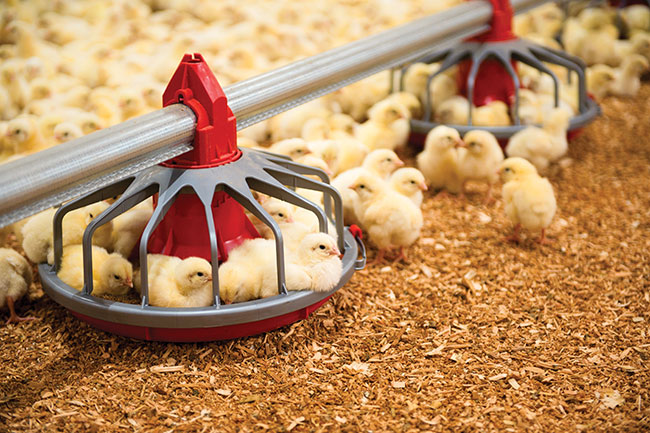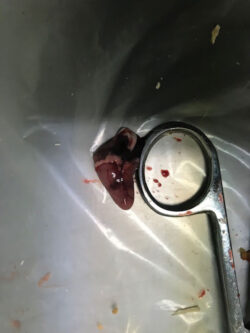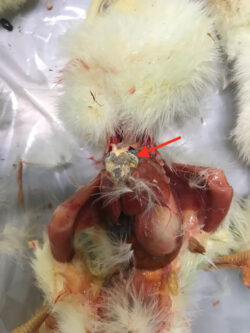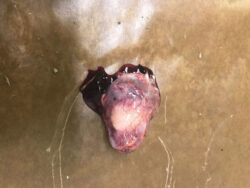
The Brooding Notebook: White heart
By Dr. Gigi Lin
Features BroilersIn a flock of chicks experiencing increased mortality, some had a white sac covering their heart. Here's what the veterinarian found.

It was on a Monday morning that I received a call from a broiler grower who was concerned about his five-day-old flock, which had experienced a sudden increase in mortality (two per cent) over the weekend. The grower believed that the chicks had bacterial infection and was hoping to treat them with antibiotics.
He was convinced that the flock had bacterial septicemia because, upon opening up some chicks, he noticed their hearts were covered by a white sac – a lesion he learned about in a recent poultry disease webinar. I made a field visit to launch the disease investigation.
Before entering the barn, I performed an on-farm necropsy to confirm the cause of death. None of the chicks showed signs of bacterial infection; most had varying amounts of feed in the crop and gizzards.
All the chicks had gross lesions consistent with severe dehydration, including: sunken eyes; dry, shriveled, dark skin on the lower legs; dark and dry muscles; swollen, distended ureters; and pale kidneys.
The most prominent lesion was visceral gout, characterized by chalky, white deposits on the surface of the hearts (and sometimes on other organs such as the livers) – a lesion that can be mistaken for fibrinous pericarditis found in chicks with systemic bacterial infection.

Pictured is what a normal broiler chicken heart looks like. PHOTO CREDIT: Dr. Gigi Lin
To expedite a treatment plan and reduce losses, it is important to obtain an accurate diagnosis from a poultry veterinarian or pathologist, as some of the lesions can have similar appearances. Visceral gout (chalky, white deposits) and fibrinous pericarditis (pale yellow cheese-like layer) are induced by different causes; therefore, both require different interventions.
Visceral gout, a condition resulting from the deposition of urates on various organs, is commonly found in young chicks suffering from dehydration. Although relatively rare, visceral gout can also result from kidney damage due to various primary causes such as infection, nutritional imbalance, and toxicity. Once again, it is crucial to emphasis that making an accurate diagnosis is the first and most important step of disease investigation.
Although the necropsy findings clearly showed that the chicks suffered from dehydration, I still conducted a comprehensive brooding assessment to ensure that there were no
factors deterring the chicks from accessing the water source. For example, as I discussed in my previous column, high carbon dioxide levels in the barn can induce huddling behaviour and reduce birds’ water and feed intake.

A heart with visceral gout (chalky white deposits) from dehydration.
Based on the brooding assessment, the barn had excellent brooding conditions in general in terms of the temperature setting, feed supply, litter condition, air quality, and sanitation. All the waterlines were at the correct levels with clean water supply on both ends. However, upon testing all the drinking nipples, all five waterlines had sections with no water flow, accounting for over 25 per cent of the overall water supply.
Through further investigation, I found that the waterlines were unleveled for maintenance and drinking nipple replacement over the downtime period. These actions likely induced trapped air in the waterlines, creating air locks that restrict water flow in various sections.
Fortunately, dehydration is generally easy to treat simply by resuming consistent fresh and clean water supply. All the waterlines returned to full function after the grower flushed them and readjusted the water pressure. The flock returned to normal condition within 24 hours after the resumption of water supply.

A heart with fibrinous pericarditis (pale yellow, cheese-like material).
Before flock placement, in addition to leveling and sanitizing the drinker lines, remember to trigger most of the drinking nipples to help identify clogged sections or areas of restricted water flow even after a round of high-pressure flushing.
In some scenarios, inadequate water flow could be identified early if chicks are observed pecking at the water nipples aggressively or spending more time drinking. Young chicks are very susceptible to dehydration and will die quickly. This is especially the case beginning on the fourth or fifth days of life, once they consume the water and nutrients from the yolk sacs.
Dr. Gigi Lin is a board-certified poultry veterinarian. She provides diagnostic, research, consultation, continuing education, and field services to all levels of the poultry industry in Western Canada. In this column, she will share case-based reviews of brooding best practices.
Print this page